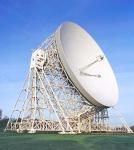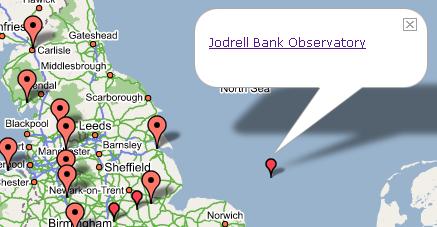Jodrell Bank on the move?
 Some time last year there was some discussion on the SPA BB about the location of various posters and how people could best make the information available to others. One poster suggested that it would be handy if there was some sort of map that people could look at. I'd been looking for a reason to play with the Google Maps API so decided to have a go. Later on that day the SPA Forum User Location Map was born.
Some time last year there was some discussion on the SPA BB about the location of various posters and how people could best make the information available to others. One poster suggested that it would be handy if there was some sort of map that people could look at. I'd been looking for a reason to play with the Google Maps API so decided to have a go. Later on that day the SPA Forum User Location Map was born.
Last night, in an idle moment, I decided to revamp it a little and one idea I had was to add the locations of various sites of astronomical interest to it (the idea being to add places that are open to visit so people using the map can see how close they are to these places of interest). Today, in spare moments, I've been looking around for places to add.
An obvious candidate was Jodrell Bank. The really nice thing about their website is that they give their location on the front page:

Thing is, at first glance, it didn't look right. +2° longitude? Really? By my guess that places Jodrell Bank somewhere in the North Sea.
Just to be sure it would be that wet a location I added them to the map using the coordinates they give and this was the result:

No wonder Megan is always talking about observing from a roof!
Given that their number is on the front page too I gave them a call and asked to speak to the webmaster. Got to speak to someone and pointed out what seemed to be a rather amusing mistake. As of the time of writing they seem to have changed it:

Perhaps it's just me, but that seems confusing as opposed to wrong. Either it's a method of writing longitude I've not seen before or most people are going to see that and wonder if the "+" or the "W" is a mistake.
File Under: Jodrell Bank, North Sea.





9 comments:
Hi Dave,
Well, it seems to me it has to be either +2.8 degrees OR 2.8 degrees west. It's a bit like writing 2145hrs pm. Are you going to follow up or just leave it?
The best analogy I could think of was being handed two bars of metal, being told that one of them is a magnet, and being asked to figure out which is the magnet using only the two bars of metal.
When I spoke to the chap at JB he sounded a little surprised and said something along the lines of "I'm not sure what standard is used" and that he'd "need to go and find out". Wanting to be sure I'm not missing out on any standards I asked if he'd drop me a line to let me know what he found out.
So, I was going to give it the night to let an email turn up and then possibly follow it up and ask how they arrived at what they've got now.
I wonder who you were speaking to... Anyway, the locations of all the MERLIN telescopes, including the Lovell telescope, can be found in the user guide here. For interferometry (where we use several telescopes together, as in MERLIN) it is very important to know exactly where our telescopes are, otherwise the signals are not combined properly and we don't get any useful data. The definition that seems to be in use for longitudes in that document and on the front page does seem to be at odds with what is commonly adopted, which as you say is very confusing, but these aren't the numbers normally used by the software that processes the data. May be no one noticed before!
Thanks for that pointer Megan. It's interesting to see that "+" is used for west there too. Presumably the value given on the front page of the website was taken from such a document?
As for why they're using a convention that seems at odds with what people normally use — I'm wondering if it comes from the USA? I've seen this sort of thing before. In one case, in the programming language ANSI Common Lisp, timezones are taken into account for time data but positive zones are west of Greenwich and negative zones are east of it; different from how we'd normally do things.
It's almost as if someone sat down, thought "it's only going to be used here so let's make data entry a little easier" and decided to reverse the sign. Then, at some point, the design spread elsewhere.
Yes, the value on the website was probably taken from the user guide. Most people I've spoken to seem to think that the W = positive convention is perfectly normal, I guess it's just what you're used to. But hey, even the BBC get it wrong, their article on today's announcement of the five-Earth mass planet contains the following: "Dr Nicholas Rattenbury, from Jodrell Bank Observatory in Liverpool..." Hmm.
Interesting. I don't think I've ever seen "west is positive" before.
As for the "Liverpool" thing — there's a way to annoy a few people. ;)
I see the article has been corrected.
Dave, I am (partly) to blame for the figure quoted on the JBO front page. When I was given the task to rebuild the website using the official 2004 University of Manchester website design (in time for the joining of UMIST and University of Manchester), I thought it would be handy to put the longitude and latitude on the front page. It was then that I discovered there were (at least) three different figures quoted on the website for the observatory (or Lovell telescope). Different figures were from different times by different methods. There may even be some human errors in there too. In the end I settled on the numbers from the MERLIN User's Guide as Megan says. I checked them myself against numbers used by the correlator with a couple of expert MERLIN users.
For some reason that I'm not too sure of (I'm on holiday in NZ so can't look it up too easily either) west is defined as positive. Anyway, it looks as though our computer manager has resolved the ambiguity by removing the '+' and replacing with 'W'.
If you search on Google for section 4.1 of the MERLIN user guide (I can't put a link here as copy and paste seem to have been disabled in this internet cafe) you can get the positions of all the telescopes in the array.
Sorry for the confusion Dave. I hope you forgive me ;-)
Heh! Now that I wasn't expecting. I guess it is a small world after all.
I take it that the section of the MERLIN document that you're on about is the one that Megan kindly pointed to in an earlier comment (the link pointed here).
Also, thanks for pointing out that they've finally resolved the ambiguity. As you'll see from my article, at first, they'd fixed it by having the "+" and the "W" — which looked a little like saying "a left-handed right-handed glove" to me. ;)
I'm still fascinated by this thing of "+" being used to denote west, I don't think I've ever seen this convention before and I'd love to know where it comes from.
Hope you're having a good time out in NZ.
Yeah, go on, I'll forgive you. ;)
Forget Jodrell. Look where Google Earth have moved the Prime Meridian.
http://www.theregister.co.uk/2006/02/06/greenwich_meridian/
(It usually runs through the courtyard of the Royal Observatory).
Post a Comment